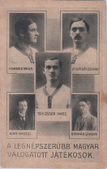
1aImre Schlosser (HUN)
c1912 Erdeckes Ujsag Postcard.
Considered the best striker of the 1910s and still the all-time scorer in the history of the Hungarian League, Imre Schlosser netted 417 career league goals. He led Ferencvárosi to five consecutive Hungarian titles from 1909 to 1913 and then led MTK Hungarian to six consecutive titles between 1917 and 1922! Schlosser led the Hungarian League in scoring in 1909, 1910, 1911, 1912, 1913, 1914 and 1917. For the Hungarian national team, Schlosser scored 9 goals in 68 appearances. When Schlosser played, the national team won 70% of its matches.
| 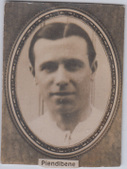
1bJose Piendibene (URU)
1928 Cigarillos Crack.
One of Peñarol’s earliest stars, Jose Piendibene won Uruguay league titles in 1911, 1918, 1921, 1924, 1926 & 1928. Piendibene was capped 40 times, scoring 20 goals for the Uruguay national team.
| 
1cÁngel Romano (URU)
c1928 Campeon Olimpico.
Ángel Romano led Nacional to eight Uruguayan league titles between 1911 and 1924. With the Uruguay national team, Romano won five Copa Américas and the gold medal at the 1924 Olympics. The legendary striker was capped 68 times.
|
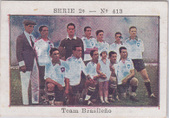
1dArthur Friedenreich (BRA)
1926 Dolar.
Brazil’s first black player and the world’s first black superstar, Arthur Friedenreich was a dominant striker in the late 1910s and early 1920s. Some sources say he scored 1329 goals in his career, although FIFA cannot confirm his goal total due to poor record keeping. He led Liga Paulista in scoring in nine different seasons. In 1925, Friedenreich’s club, Paulistano, toured Europe and won 9 out of 10 games against French clubs. Friedenreich scored 11 goals in those matches and was touted as the “King of Football.”
| 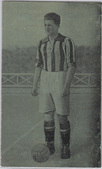
1eAlfréd Schaffer (HUN)
1925 Jugadores Internacionales.
Alfréd Schaffer was the top scorer in all of Europe in the 1918 and 1919 seasons as he and Imre Schlosser led MTK Hungarian to three consecutive league titles. "Spezi” played for a record 21 clubs in a 15-year career.
| 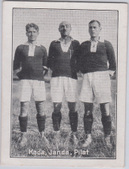
1fVáclav Pilát (CZE)
1926 Greiling.
A playmaker known for his incredible passing skills, especially his short passes, Václav Pilát had great technique, amazing ball control and shooting skills. Although considered more of a playmaker than a scorer, he tallied an impressive 323 goals in 361 games. Pilát, Karel Pešek-Káďa and Antonín Janda were the stars of the Czechoslovakian national team at 1920 Summer Olympics. Czechoslovakia reached the gold medal match, however, the team was disqualified after it walked off the field in the 40th minute of the match due to what they perceived as biased officiating.
|
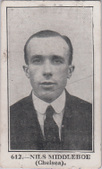
1gNils Middelboe (DEN)
1922 Bunsen Confectionery.
One of the greatest early Olympic football stars, Nils Middelboe led Demark to silver medal finishes at both the 1908 and 1912 Olympics, captaining the 1912 team. Additionally, he was a member of the 1920 Denmark Olympic team. Middelboe’s goal against France in 1908 was the first-ever goal scored by an official national team in Olympic football. Between 1904 and 1913, Middelboe won five Copenhagen football championships. In 1913, he signed with Chelsea where he played for the next nine seasons.
| 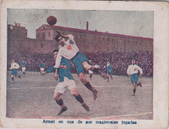
1hJosé Belauste (SPA)
1915 Chocolate Amatller (Belauste named on Reverse).
Athletic Bilbao’s captain during the 1910s, José Belauste and Rafael Moreno Aranzadi (AKA “Pichichi”) led the team to five Copas Del Rey between 1911 and 1921. Belauste started for Spain’s inaugural national team in 1920, which was awarded the silver medal after Czechoslovakia was disqualified, Belauste scoring against Sweden.
| 
1iRenzo De Vecchi
1920s Cioccolata Piazza.
One of the best prewar defenders, full back Renzo De Vecchi appeared for Milan as just 15 years old and debuted for the Italian national team at just 16 years. He remains Italy’s youngest ever international. De Vecchi stood just 5’4”, but his status as a player was monumental. He was known by the Milan supporters and his teammates as “Figlio di Dio” (“The Son of God”) because he had no flaws. De Vecchi was sold for a record price to Italy’s best team, Genoa, where he won three national titles and captained the club for 8 years. Over the course of 15 years (interrupted by war) De Vecchi represented Italy 43 times, taking part in both the 1912 and 1924 Olympic Games.
|
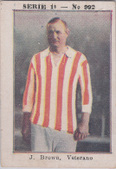
1jJorge Brown (ARG)
1925 Dolar.
Few footballers dominated their contemporaries as did Jorge Brown. Playing for the Alumni Athletic Club, Brown won 9 of 12 Argentine Primera División championships between 1900 and 1911. The following year, he moved to Quilmes where he won another league championship. Brown was capped 23 times by his country including 18 appearances as national team captain between 1908 and 1913. A multi-sport athlete, Brown continued to play cricket after his retirement from football, captaining the Buenos Aires Cricket Club until 1927.
| 
1kSam Hardy (ENG)
1907 Taddy
One of the best goalkeepers of his generation, “'Safe and Steady Sam” Hardy played for Liverpool and Aston Villa, winning a league title with the former club and two FA Cup winners medals with the latter. He was also England's premier goalkeeper between 1907 and 1920.
| 
1lJimmy Hogan (ENG)
1907 Taddy’s “Prominent Footballers”.
Jimmy Hogan is the father of total football and one of the great pioneers of the game on the continent, especially in Austria, Hungary, Switzerland and Germany. Hogan took shared his knowledge across Continental Europe. From 1914 and 1921, he coached MTK Budapest where he led them won five league titles. Fast forward to 1953, shortly following the Hungarian national team’s defeat of England in what was billed the “Match of the Century,” Sandor Barcs, president of the Hungarian Football Association, said: "Jimmy Hogan taught us everything we know about football."
|
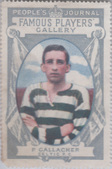
2aPatsy Gallacher (IRE)
c1911 People's Journal.
Right winger Patsy Gallacher was born in Ireland but moved to Scotland as a young child. He played for Celtic from 1911 to 1926, scoring 192 goals in 464 appearances. Standing only 5’7”, Gallacher had one of the coolest nicknames, “The Mighty Atom.” His fame increased interest in football in Ireland, 50,000 fans coming to see Gallacher’s Irish national team debut at Windsor Park in Belfast versus England. Gallacher once snuck out of a hotel, while Celtic was under curfew, dressed as a chambermaid.
| 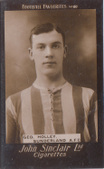
2bGeorge Holley (ENG)
1906 John Sinclair Cigarettes.
Inside forward George Holley was Sunderland’s top scorer for five seasons and he helped his club win a league title in 1913. He was the Football League’s join top scorer in the 1911-12 season. In all, he scored 154 goals in 315 club appearances for Sunderland. Holley was also capped 10 times for England, scoring 8 times.
| 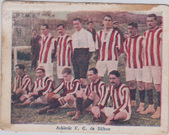
2cPichichi (SPA)
1915 Chocolate Amatller (Athletic Bilbao Team Card).
Rafael Moreno Aranzadi is more commonly known by his nickname “Pichichi” which means “Little Duck.” Today, the Pichichi Trophy is awarded each season to the highest goal scorer in La Liga. As a striker for Athletic Bilbao, Pichichi and José Belauste led the club to four Copa Del Rey championships. He was a member of Spain’s inaugural World Cup team in 1920. Pichichi died in 1922 at age 29 due to a sudden attack of typhus. This team card is the only card I know of depicting Pichichi and issued during his lifetime. Pichichi is sitting in the front row on our far left.
|
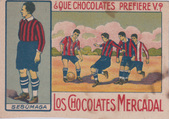
2dFélix Sesúmaga (SPA)
1919 Chocolates Mercadal.
Félix Sesúmaga was a Spanish Basque player who won the Copa Del Rey three different times between 1919 and 1923 with three different clubs. As a member of Jack Greenwall’s famous Barcelona team, he won three consecutive Catalan football championships beginning with the 1918-19 season. Sesúmaga was a member of Spain’s inaugural national team. In the 1920 Olympics, he scored twice to help beat the Netherlands 3-1 in the playoff for the silver medal.
| 
2eCharlie Buchan (ENG)
1912 Murray & Co.
Sunderland’s all-time scorer, Charles Buchan was the club’s leading scorer in 7 of his 9 seasons. He led Sunderland to a league title in the 1912-13 season and to the finals of the FA Cup in 1913. Buchan made several other important contributions to football – together with Herbert Chapman, he designed the “WM” formation which Arsenal would use to great success in the 1930s. Following his retirement, Buchan was a commentator for the BBC, wrote one of the first coaching manuals and co-founded the Football Writers’ Association. He also wrote his own football magazine, Charles Buchan’s Football Monthly, which was published until 1974.
| 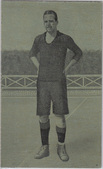
2fRené Petit (FRA)
1925 Jugadores Internacionales.
The son of a French father and Spanish mother, René Petit is said to have modernized Spanish football, by establishing passing and team play. He won a Copa Del Rey with Real Madrid in 1917 and was runner-up the year before. The next season, now with Real Unión, he defeated his former team Madrid in the Copa Del Rey finals, Petit scoring in the 85th minute.
|
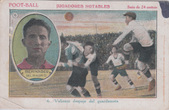
2gSantiago Bernabéu (SPA)
1923 Jugadores Notables.
Better known for transforming Real Madrid in his role as president, Santiago Bernabéu de Yeste was a talented midfielder and striker. Between 1915 and 1927, he won 9 Regional Championships and 1 Spanish Cup with Real Madrid. Bernabéu captained Real Madrid for years and cored more than 200 goals for the club.
| 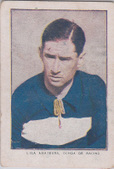
2hPedro Ochoa (ARG)
1925 Dolar.
Pedro Ochoa debuted for Racing Club’s senior team at 16, where he would spend his entire career. Nicknamed “El rey de la gambeta” (“The king of dribbling”), the playmaker led Racing to national titles in 1916, 1917, 1918, 1919, 1921 and 1925, plus 4 national cups and 2 international cups.
| 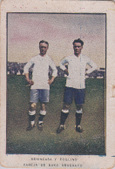
2iAlfredo Foglino (URU)
1925 Dolar.
One of the first great Uruguayan defenders, Alfredo Foglino played his entire career with Nacional which he captained for 10 years. Between 1912 and 1924, he won an incredible 9 Uruguay league titles with the club. Capped 47 times by Uruguay, Foglino help his country win the first two editions of the South American Championship in 1916 and 1917. In those tournaments, Foglino partnered with another Uruguayan defensive great, José Benincasa, who is also depicted on the 1925 Dolar card.
|
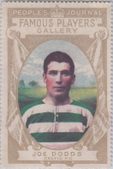
2jJoe Dodds (SCO)
c1911 People's Journal.
A quick and dependable left back, Joe Dodds was considered among the Celtic greats of his era, helping form one of the best club defenses in the world at the time. He made 351 appearances in two different spells with the club. Dodds was unbeaten in his 3 full caps for Scotland. Dodds also represented the Scottih League XI eight times between 1912 and 1920.
| 
2kPierre Chayriguès (FRA)
1923 Felix Potin.
Just 13 years old in 1906 when he started for Ja Levllois, a Parisian suburb club, Pierre Chayriguès would also become the youngest goalkeeper to represent the French national team, at age 19, in 1911. He would go on to represent both Red Star and France from 1911 to 1925. He started for France at the 1924 Olympics where he was injured while trying to stop a goal attempt by Uruguyan striker Pedro Petrone. With Red star, Chayriguès won a league championship in 1912 and three consecutive Coupes de France from 1921 to 1923.
| 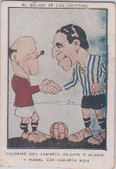
3aPedro Calomino (ARG)
1925 Dolar (w/Moses Russell).
Possible inventor of the bicycle kick, Argentine striker Pedro Calomino was the leading scorer for Boca Juniors for six seasons between 1913 and 1919. He led the club to 4 Primera División championships in 1919, 1920, 1923 and 1924. He was capped 37 times by the Argentina national team and captained the team to victory at the 1921 South American Championships.
|
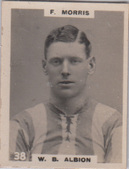
3bFred Morris (ENG)
1921 Pinnace.
Inside-left forward Fred Morris had the second-best season in Division One football, netting 58 goals in 1919-20 season. If not for Dixie Dean surpassing his record, everyone would know the name Fred Morris. He also lest his club, West Bromwich Albion to a league championship that year.
| 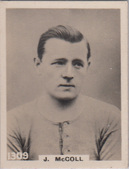
3cJimmy McColl (SCO)
1922 Pinnace.
Center-forward Jimmy McColl led Celtic to 5 league titles in 6 years between 1913 and 1919 as well as the 1913 Scottish Cup. The top scorer in the Scottish League in the 1915-16 season, McColl scored more than 250 league goals during his career.
| 
3dLeo Bosschart (NED)
1907 Union Cigarettes.
Left-half Leo Bosschart captained the Dutch national team in the 1920 Olympics where the side finished third. He was capped 19 times by the national time during his career. Bosschart was considered an all-rounder, starting at multiple positions for the national team.
|

3eJan Voss (NED)
1907 Union Cigarettes.
Jan Vos was a member of the Dutch national team that won the bronze medal at the 1912 Olympics. He scored an impressive 8 goals (third-highest) in the tournament.
| 
3fJesse Pennington (ENG)
1908 Ogden’s Famous Footballers.
One of the top defenders of the early 20th Century, left-back Jesse “Peerless” Pennington made 455 league appearances for West Bromwich Albion, captaining them to the league title in 1919–1920. He was capped 25 times by England between 1907 and 1920, captaining the side in his last two matches.
| 
3gJock Simpson (ENG)
1909 F&J Smith
English forward Jock Simpson was raised in Scotland where he enjoyed a successful career at Fallkirk, scoring 116 goals in 269 appearances. He transferred to the Blackburn Rovers £1800 in 1911 where he quickly led the club to first division titles in 1912 and 1914. Simpson was caped 8 times by England.
|

3hAndy Ducat
1907 Taddy.
Andy Ducat starred for Arsenal and Aston Villa, leading the latter club to an FA Cup in the 1919-20 season. Ducat is one of just a few individuals to have represented his national team in both football and cricket, even winning the Wisden Cricketer of the Year award in 1920. That same year, Ducat captained Aston Villa to a victory in the FA Cup.
| 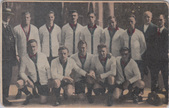
3iArmand Swartenbroeks (BEL)
1924 Eduardo Pi.
Top defensive footballer of his era, Armand Swartenbroeks led Belgium to the gold medal at the 1920 Olympics. With Daring Club Bruxelles, he won Belgian league titles in 1912, 1914 and 1921.
| |